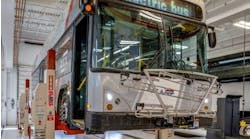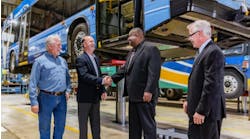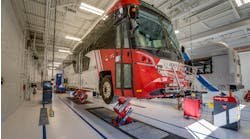Maintenance for Tomorrow Available Today
Predictive maintenance may have a higher initial cost for the software, but studies have shown a typical 8 to 12 percent savings over the long run because of the increase in reliability and availability of the vehicles. Current maintenance processes typically run on a timescale, as opposed to the actual vehicle condition. Predictive maintenance turns this around and keeps vehicles up and running. Three companies share how today’s systems are advancing fleet maintenance and monitoring.
Continental’s KIBES-32
Continental offers KIBES-32, a complete, end-to-end diagnostics system that allows users to see what’s working, failing or malfunctioning from the driver’s seat, a PC or a remote location.
The KIBES-32 vehicle multiplex networking offers advanced vehicle control and monitoring technologies so maintenance personnel don’t have to rely on physically inspecting a vehicle to see what’s working, failing or malfunctioning. Two innovative performance features it provides not available on competitive systems are centralized diagnostics and information accessibility. All diagnostics data is presented in once common display and represents advancements over the industry’s current use of LEDs to display failures, which requires technicians to open multiple access points and check multiple nodes to troubleshoot the problem. The information is easily accessible by a PC connection, remote or via the driver’s instrument panel. It can also be configured to provide specific information to different personnel, depending on what is pertinent to their responsibilities.
KIBES-32 saves on design, build and installation costs by replacing bulky wiring harnesses and conventional electronics with a flexible multiplex architecture. This system allows for easy connection to the various components throughout the vehicle.
The software system utilizes Windows PC-based PLC programming and is built on an open and scalable product platform, using both off-the-shelf and custom components that can be mounted and configured in a variety of ways. This system allows for flexibility in operational, diagnostic and developmental parameters to meet bus manufacturers and agencies needs.
Matt Williams, key account manager, special vehicles NAFTA for the Continental Commercial Vehicles & Aftermarket Business Unit, explains that it’s the company’s 100-year history and automotive experience where a lot of the technology is born out of. With his focus on the bus market, he sees the truck business following the automotive business and the bus business following the truck business. “With the relationships that we have with all the major auto manufacturers of the world, especially with some of these premium brands like VW and Daimler, you don’t survive that world without having great products, superior technology manufactured correctly and good relationships.
“Our ability to do that really allows us to then take those experiences and bring them into the truck market and it’s been tried and true.” He adds, “That’s one of the things as a company that differentiates us from our competition. We’re just so integrated within the business in all aspects.”
When Williams talks about the American transit market, he says he’s starting to see that the challenges that it’s faced with in terms of infrastructure, populations into the cities, the transient population is creating infrastructure problems here that the European markets have dealt with for a long time.
With the majority of European transit buses having their system on it, he says they have a technology that’s already distributed for a market and it is the standard in a market that is dealing with the things the United States is going to be needing to address in the future.
“I see this all the time; our competition has got great products for today. We’ve just got great products for tomorrow,” Williams says. “When we come to the table we say, ‘OK, we have got a solution that not only helps you today, but it’s going to help carry you into your next stages of development and as you start to resolve these infrastructure issues.”
One of the challenges in explaining how this technology works is adjusting how people think about transit bus maintenance. Where the service mechanic in the past would look at the problem, he or she would pull out the manual and look into the ladder logic that is behind that portion of software programming of the bus and work through to diagnose where the problem lies.
Williams compares this to the mechanic working on a car and when there’s an issue, they simply hook the vehicle up to a machine and all that data is pulled off the machine and the vehicle itself tells the mechanic what is wrong with it. “I have a hard time explaining why that was always the case,” Williams says. “It’s because there is so much customization done at very low volumes for different cities.
“The idea with this ladder logic is just outdated,” he stresses. “Our system can provide the ability to connect all the different subsystems on the vehicle. You put all that information together and just provide the diagnostic codes in one place, just like you would with an automotive system.
“The question keeps coming up, ‘Can you do ladder logic?’ And the idea is, it’s not even a relevant question anymore. We make ladder logic obsolete.”
As for software integration or network integration, Williams says they don’t do that themselves, they have partnered with Logena Automotive who’s been doing it for decades. This allows the bus manufacturer to focus on what they do best, and Logena consults and assists with integrating the system and getting together all the subsystems together in the most effective and cost-effective way possible.
NetworkFleet
NetworkFleet just celebrated its 10th anniversary last August. Founded by Diego Beiego, now the vice president of hardware engineering, while he was at MIT in grad school and working at General Motors, he came up with the idea of plugging into the OBD port of a vehicle and getting the information off of that.
The remote diagnostics interfaces with the engine computer to quickly provide valuable information to fleet managers when a problem occurs and provides diagnostic summary reports. It can communicate with a variety of vehicle protocols and standards, including CAN, ISO, J-1708 and J-1939.
When a diagnostic trouble code is triggered, an email notification is sent specifying the code and a description of the problem.
“He came up with this concept where we have this black box that’s underneath the dash, that’s inside as a GPS module and it has a cellular modem so it can transfer the information. It has a computer and it then plugs in to the engine computer,” says Craig Whitney.
If it’s a light-duty vehicle like a car or smaller trucks, they have an OBD port that the scan tool plugs in a heavy-duty vehicle, explains Whitney. As for buses and trucks, they have a J-1708 to plug into. “One of the pieces that we do is we plug into the engine computer, we have the ability to get the diagnostic information.
“So then it goes through and every two minutes it keeps track of where the vehicle is based on the GPS coordinates, how fast the bus is going, how the engine is running; it is pulling all kinds of different engine information out of there.”
He explains, “If you’re driving a car and that wonderful check-engine light comes on, it triggers what’s called a diagnostic solo code and whether it’s in a car or big trucks or buses, they all generate these diagnostic trouble codes and they basically give you information about what’s wrong.
“If one of those diagnostic trouble codes gets triggered, it automatically gets sent from the unit back to the Web site, so now the fleet manager or the maintenance manager knows this vehicle has this issue and they’re warned that it may be early indications of a problem.” He stresses, “You know in real time that this is happening.”
Whitney says that with the buses and heavy-duty vehicles, the diagnostic codes have three parts to it and they indicate which major system it is and the second piece that talks about the module components. “So it may be that the engine is the problem, the subsystem is the coolant and the operational thing is that it’s overheating.” He continues, “It sent you this series of codes and it’s a numeric code that the maintenance manager gets and can translate and know what that code says.”
The other aspect he mentions is that they have the odometer reading on there as well, so maintenance managers can have that information automatically grabbed and sent. “They know when they need the scheduled maintenance,” he says.
As with all systems he agrees that there’s somewhat of a learning curve, but the system is designed to be easy-to-use. The system integrates into various maintenance management software packages and it’s a relatively easy plug-in. “It just starts feeding more information in to it,” Whitney says. “You have to go through on the other side and learn how to run reports and a few things that really help you to manage your fleets better.”
Bombardier’s Orbiflo and Orbita
Bombardier's Director, ORBIFLO Program, Mikel Doucet provides information on how ORBIFLO/Orbita provides an innovative and intelligent wayside solution for rail:
Orbita was launched in a pilot project with First ScotRail in the United Kingdom in 2006. The pilot involved monitoring 33 three-car Class 170 Turbostar units. Today, Orbita gathers data from more than 2,900 vehicles across the United Kingdom, Europe and Africa with more than 150 users now regularly logging in to the Orbita solution. Orbita is a service offering composed of people, processes and tools that help identify train service issues before they occur and perform root cause analysis of occurred problems. "It combines data gathered from the trains with Bombardier Transportation's global fleet knowledge and engineering expertise to enable active, holistic management of vehicle and infrastructure maintenance, performance and operation."
The tools component used in Orbita is the ORBIFLO software product suite which is an integrated solution that remotely manages operations, passengers, security and maintenance aspects. The ORBIFLO solution is composed of four parts that Doucet explains simply as: obtaining data, transferring the data, storing/managing the data, and accessing/analyzing the data. With the obtained data, it is possible to know precisely the current fleet status in real time for operations purposes. Since the trains-to-wayside communication link is bidirectional, it is also possible to request specific information and perform some remote tasks (e.g. to power-up the train remotely and to update the timetables for the ‘Passenger Information System’).
With the history of collected data, it is possible to automate and alert the users of trends occurring in the train data. Doucet shares that trend analysis enables prevention of in-service failures, increasing reliability and availability of the rolling stock. "On average, 15 percent, evolving to 30 percent with more intelligent vehicles, of failures can be trended and warnings can be issued before an event occurs."
The ORBIFLO/Orbita solution enables proactive identification of problems Doucet says. It converts data into meaningful information, enabling better maintenance planning. Also, quicker investigation times can significantly reduce operating costs.
For transit agencies, this also allows for maximum fleet utilization and availability, ensuring trains run on time, every time and passengers enjoy a better traveling experience, Doucet says.
Choosing a System
Each of the systems has a passionate force behind it with experience and knowledge to share with agencies. Whitney of NetworkFleet says, “There are a lot of different companies out there that do these kinds of things, so you really need to look at them carefully and understand what they are capable of doing and what they are not capable of doing, how it works, how integrated it is, and how long they’ve been around.
“These are fairly significant investments; you’re going to spend a lot of time and a fair amount of money getting them installed and integrated so you want to make sure the company’s going to be there for the long term.”
Williams of Continental says, “This is really cool to be pointing at right now because there is this big change happening; there’s money being invested; this European influence is coming in, you can see the story unfolding, it’s going to be a different marketplace in 10 years.
“That’s why I’m working every day to be a part of that change and to assist it whenever possible.” He adds, “We’re just excited to be a part of that.”





